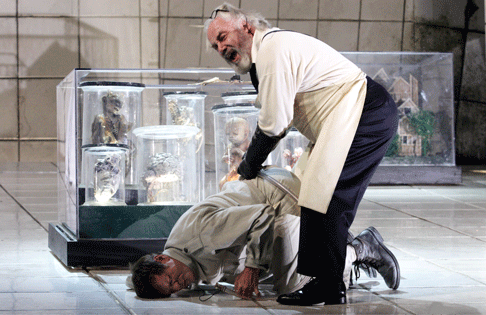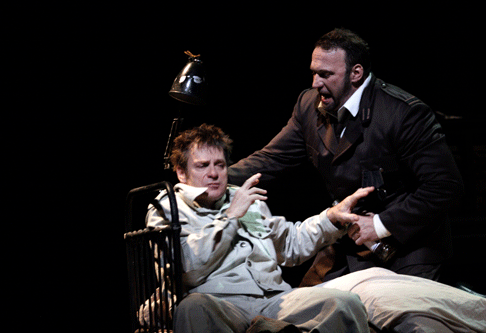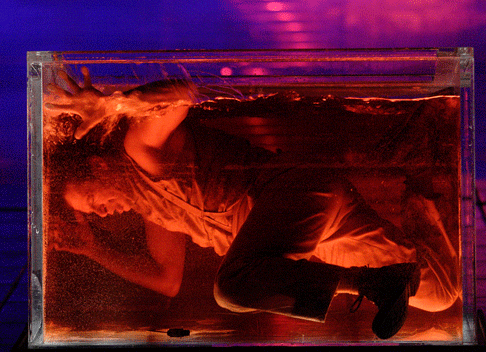Only Marie’s small, shabby
bedroom, to the front left, provide some respite from the unalleviated
soullessness.
First seen in 2002, winner of an Olivier Award for Best New Opera Production
in 2003, and revived in 2005, Warner’s staging asks much of its personnel.
The institutional grimy white is transmuted only occasionally by a black
triangular shape which descends from the flies, and by the mirrored wall onto
which Wozzeck’s mysterious hallucinations are projected (lighting design,
Rick Fisher); this single-set offers little assistance to the singer who must
convey Wozzeck’s misery and oppression as, ever more humiliated and betrayed,
his world shrinks to become a claustrophobic prison of mental confinement.
Buchner’s Wozzeck is deeply affected by the natural world, but here there
are no external locales, no mists or rising suns, no eerie moonlight; the
toad-stalls which so disturb Wozzeck — small, delicate rings, wondrously
inscrutable beneath the arching, glittering constellations above — are here
giant-sized, contained within one of four the clinical glass tanks in which the
Doctor conducts his experiments.
In Warner’s concept we seem to be within Wozzeck’s own mind — a mind
which is already unhinged at the start of the opera. It’s certainly the case
that by the end of Berg’s opera we see, and hear, the world through
Wozzeck’s perspective: the lullaby which the bar maid sings to Wozzeck when
he stumbles into the tavern after his horrific act; the deafening, hysterical
cries of the crowd, ‘Blood! Blood!’, when his crime is discovered; the
rising parallel scales as Wozzeck sinks to his depths of the pool of water in
which he strives in vain to rinse the bloodstains from his hands — all of
these musical details present us with a world seen through Wozzeck’s eyes, a
world distorted by his own obsessions and fears. But, we need the context to
appreciate this warped subjective vision. The grotesques with which Berg
presents us are not simply caricatures, or abstractions of cruelty, they are
representatives of the selfish, heartless ruling class, one that subjugates the
less fortunate, forcing them into financial and moral impoverishment. This is
the society that defeats the humble Wozzeck, a member of the oppressed
under-class, who is driven to commit murder by his poverty and powerless.
 Simon Keenlyside as Wozzeck and John Tomlinson as Doctor
Simon Keenlyside as Wozzeck and John Tomlinson as Doctor
Baritone Simon Keenlyside is an experienced veteran in the title role -
this year alone he has already performed the part in Vienna, Madrid and Munich
- but in some ways he might be thought too physically suave and composed to
convince as the mentally ravaged soldier. But, Keenlyside showed us the
psychological rawness while maintaining the essence of Wozzeck’s humanity,
the beauty of the vocal lines drawing us into his confusion, the variations of
colour and nuance revealing the depth of that bewilderment. The lightness of
his baritone contrasted effectively with the Doctor’s deep bass, emphasising
further Wozzeck’s defencelessness; progressively dehumanised, rendered ever
more inarticulate, Keenlyside evoked a powerful sense of Grimes-like alienation
from those around him. His interactions with his child, played with acuity by
Sebastian Wright, were painfully poignant.
Keenlyside’s voice is essentially lyrical and herein lies a small
misgiving though, for the eloquence of the vocal lines was sometimes at odds
with the primitive brutality of the experience. The baritone, in common with
virtually all the cast, doesn’t make much of the Sprechstimme but
some vocal ‘roughness’ is needed to project the tragedy of this
“psychotic anti-hero” (Derek Jarman). The contrast of lyrical and
half-spoken utterance can be deeply expressive, as in the drowning scene in Act
3 when, as he desperately searches for the murder weapon, Wozzeck’s
Sprechstimme ‘All is still and dead’ contrasts with his ferocious
shouts of ‘Murder’. ‘Who cried?’ he wonders, then realises that it was
he himself who spoke; the different vocal idioms reveal a destructive
fragmentation of both body and psyche, one which is made more poignant when
Wozzeck then sings tenderly over Marie’s dead body: ‘Marie! What is that
crimson necklace you’re wearing? Was that well-earned, or sinful, just like
the earrings?’ Has he really forgotten what he has done?
Singing the role of Marie for the first time, Karita Matilla sang with
typical fearlessness and passion. However, though dressed in a cheap floral
frock and hiding her own blond hair beneath a grubby brown wig, Matilla perhaps
retained rather too much of her natural poise and grace, her tone too
consistently sensuous and alluring for a rough and ready adulteress. The silky
high notes in her prayer scene were truly beautiful though, and in Act 3
Matilla’s declamations were full of urgency and anguish.
 Simon Keenlyside as Wozzeck and Endrik Wottrich as Drum Major
Simon Keenlyside as Wozzeck and Endrik Wottrich as Drum Major
John Tomlinson’s Doctor was no cartoon-esque ‘mad scientist’, but
rather a cruel, callous manipulator, for whom each and every man and woman is a
potential medical specimen, ripe for merciless experiment, no more deserving of
compassion that a shark in formaldehyde. Tomlinson acted the part of the
obsessive maniac superbly, although the vocal performance was a little uneven.
The Doctor’s hideous duet with the Captain, Gerhard Siegel, was
appropriately ghastly, a masterpiece of caricature, the magnification of
abnormality verging on madness which they use to control and exploit Wozzeck.
Siegel relished the Captain’s idiocies, formidably establishing his moral
vacuity in the opening scene with Wozzeck, his tenor muscular and strong as he
rambled interminably about his superior intellect and status, spouting
empty-headed philosophical sound-bites.
Endrik Wottrich’s Drum Major sounded a little strained, but his steely
tone suited the callousness of the abusive lecher, and he acted well. John
Easterlin might have made more impact as Andres, Wozzeck’s companion; his
folky huntsman’s song in Scene 2 should ideally contrast more strikingly with
Wozzeck’s eerie Sprechstimme utterances, indicating the schism that
separates these supposed friends. Allison Cook (Margret) and Robin Tritschler
(Half-Wit) performed well in their cameo roles, and Jeremy White and Grant
Doyle acquitted themselves ably as the First and Second Apprentice
respectively. The ROH chorus were rather genteel for a crowd of soldiers,
workers and revelers who have not yet had the life spirit syringed out of them
by the Doctor.
One of the most discomforting and expressively provocative aspects of this
production is that the blank desolation of the sets is completely at odds with
the expressive richness of Berg’s score. And, in Mark Elder’s hands this
disjuncture proved even more shocking as the conductor drew orchestral lines as
incisive and piercing as a surgeon’s scalpel, dissecting the complex textures
with clarity and power. Grating trombone rasps, the Dantesque dancing of the
double bassoon, glistening harp sweeps, ghostly double bass col legno:
the musical juxtapositions of distress and beauty did much to convey the
discomposing confusion of Wozzeck’s world and mind. The fierce timpani hammer
blows which cry out in fury at Wozzeck’s death were earth-shattering. Superb
playing by the ROH Orchestra externalised the inner anguish of those on stage,
literally voicing their suffering.
At the start, Wozzeck and Marie’s child sits alone at a desk studying a
book; presumably scrutinising a copy of the annotated anatomical drawing of the
human head which adorns the front-drop. What knowledge does he seek? The
workings of the human mind? The causes of his father’s ‘madness’? The
meaning of human existence? On-stage throughout, the child observes all, even
witnessing his mother have brutal sex with the Drum Major — repulsively, the
latter buys the child’s silence with a grubby coin.
 Simon Keenlyside as Wozzeck
Simon Keenlyside as Wozzeck
At the end, we wonder what the child has learned, as he stares into a tank
of blood-stained water, transfixed by his father’s bloated body, while his
mother’s corpse lies to the right, disregarded. Amplified voices echo from
the auditorium. There are no children’s games of hopscotch, no one to speak
to the child and tell him that his mother is dead; one word seems to sum up the
painful drama that we have witnessed — meaninglessness. But, rather than
existential disorientation, it seems to me that expressionist extremity is
closer to the heart of Wozzeck. The violent distortions and
heightening have an expressive purpose. At the close, should not pity and
empathy accompany our feelings of horror and despair? After all, the
composer’s own sympathy for his protagonist imbues the final orchestral
interlude.
Warner’s staging is so remorseless that the danger is that we become
impassive, shell-shocked observers; stunned and aghast yes, but not moved.
Removed from his social setting and context, this Wozzeck is not a common man
suffering at the hands of society and circumstance; rather, the tragedy which
befalls him is determined by inner psychological compulsions, and yet he
experiences no revelation and as such there is no opportunity for catharsis,
through pity and fear.
That said, this is a production not to be missed. The cast perform with
absolute commitment, and we are paradoxically enthralled by the dispassionate,
abusive transactions depicted, even while we flinch from the horrors that the
cast of soulless grotesques inflict and endure.
Claire Seymour
Further performances take place on 5th,
8th, 12th and 15th November.
Cast and production information:
Captain, Gerhard Siegel; Wozzeck, Simon Keenlyside; Andres, John
Easterlin; Marie, Marita Katilla; Child, Sebastian Wright; Margret, Allison
Cook; Doctor, John Tomlinson; Drum Major, Endrik Wottrich; First Apprentice,
Jeremy White; Second Apprentice, Grant Doyle; Half-Wit, Robin Tritschler;
Director, Keith Warner; Conductor, Mark Elder; Set designs, Stefanos Lazaridis;
Costume designs, Marie-Jeanne Lecca; Lighting design, Rick Fisher; Royal Opera
Chorus; Orchestra of the Royal Opera House. Royal Opera
House, Covent Garden, London, Thursday 31st October 2013.
![Simon Keenlyside As Wozzeck and Karita Mattila as Marie [Photo © ROH/ Catherine Ashmore]](http://www.operatoday.com/Wozzeck_ROH_01.gif)


